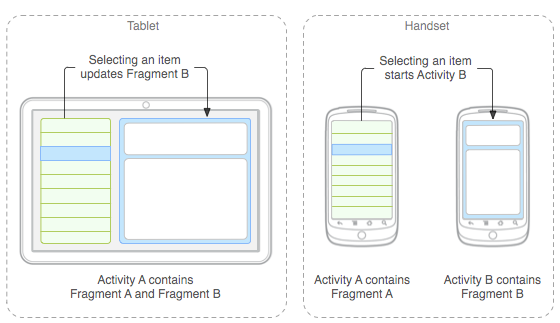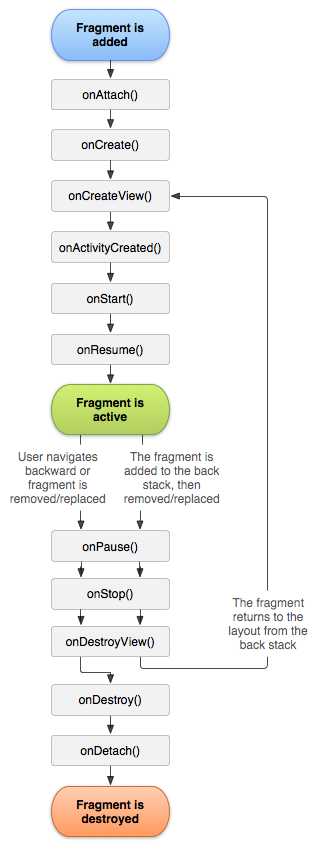Fragment简介
Fragment 表示 Activity 中的行为或用户界面部分。您可以将多个Fragment组合在一个 Activity 中来构建多窗格 UI,以及在多个 Activity 中重复使用某个Fragment。您可以将Fragment视为Activity 的模块化组成部分,它具有自己的生命周期,能接收自己的输入事件,并且您可以在 Activity 运行时添加或删除Fragment(有点像您可以在不同 Activity 中重复使用的“子Activity”)。
Fragment必须始终嵌入在 Activity 中,其生命周期直接受宿主 Activity 生命周期的影响。 例如,当 Activity 暂停时,其中的所有Fragment也会暂停;当 Activity 被销毁时,所有Fragment也会被销毁。 不过,当 Activity 正在运行(处于已恢复生命周期状态)时,您可以独立操纵每个Fragment,如添加或移除它们。当您执行此类Fragment事务时,您也可以将其添加到由 Activity 管理的返回栈—Activity 中的每个返回栈条目都是一条已发生Fragment事务的记录。 返回栈让用户可以通过按“返回”按钮撤消Fragment事务(后退)。
当您将Fragment作为 Activity 布局的一部分添加时,它存在于 Activity 视图层次结构的某个 ViewGroup 内部,并且Fragment会定义其自己的视图布局。您可以通过在 Activity 的布局文件中声明Fragment,将其作为 fragment元素插入您的 Activity 布局中,或者通过将其添加到某个现有 ViewGroup,利用应用代码进行插入。不过,Fragment并非必须成为 Activity 布局的一部分;您还可以将没有自己 UI 的Fragment用作 Activity 的不可见工作线程。
本文描述如何在开发您的应用时使用Fragment,包括将Fragment添加到 Activity 返回栈时如何保持其状态、如何与 Activity 及 Activity 中的其他Fragment共享事件、如何为 Activity 的操作栏发挥作用等等。
设计原理
Android 在 Android 3.0(API 11 级)中引入了Fragment,主要是为了给大屏幕(如平板电脑)上更加动态和灵活的 UI 设计提供支持。由于平板电脑的屏幕比手机屏幕大得多,因此可用于组合和交换 UI 组件的空间更大。利用片段实现此类设计时,您无需管理对视图层次结构的复杂更改。通过将 Activity 布局分成Fragment,您可以在运行时修改 Activity 的外观,并在由 Activity 管理的返回栈中保留这些更改。
例如,新闻应用可以使用一个Fragment在左侧显示文章列表,使用另一个Fragment在右侧显示文章—两个片段并排显示在一个 Activity 中,每个Fragment都具有自己的一套生命周期回调方法,并各自处理自己的用户输入事件。 因此,用户不需要使用一个 Activity 来选择文章,然后使用另一个 Activity 来阅读文章,而是可以在同一个 Activity 内选择文章并进行阅读,如图 1 中的平板电脑布局所示。
您应该将每个Fragment都设计为可重复使用的模块化 Activity 组件。也就是说,由于每个Fragment都会通过各自的生命周期回调来定义其自己的布局和行为,您可以将一个Fragment加入多个Activity,因此,您应该采用可复用式设计,避免直接从某个Fragment直接操纵另一个Fragment。 这特别重要,因为模块化Fragment让您可以通过更改Fragment的组合方式来适应不同的屏幕尺寸。在设计可同时支持平板电脑和手机的应用时,您可以在不同的布局配置中重复使用您的Fragment,以根据可用的屏幕空间优化用户体验。 例如,在手机上,如果不能在同一Activity 内储存多个Fragment,可能必须利用单独Fragment来实现单窗格 UI。

图 1. 有关由Fragment定义的两个 UI 模块如何适应不同设计的示例:通过组合成一个 Activity 来适应平板电脑设计,通过单独Fragment来适应手机设计。
例如—仍然以新闻应用为例—在平板电脑尺寸的设备上运行时,该应用可以在Activity A 中嵌入两个Fragment。不过,在手机尺寸的屏幕上,没有足以储存两个Fragment的空间,因此Activity A只包括用于显示文章列表的Fragment,当用户选择文章时,它会启动Activity B,其中包括用于阅读文章的第二个Fragment。因此,应用可通过重复使用不同组合的Fragment来同时支持平板电脑和手机,如图 1 所示。
创建Fragment
要想创建Fragment,您必须创建 Fragment 的子类(或已有其子类)。Fragment 类的代码与 Activity 非常相似。它包含与 Activity 类似的回调方法,如 onCreate()、onStart()、onPause() 和 onStop()。实际上,如果您要将现有 Android 应用转换为用Fragment,可能只需将代码从 Activity 的回调方法移入Fragment相应的回调方法中。
通常,您至少应实现以下生命周期方法:
(1)onCreate()
系统会在创建Fragment时调用此方法。您应该在实现内初始化您想在Fragment暂停或停止后恢复时保留的必需Fragment组件。
(1)onCreate()
系统会在创建Fragment时调用此方法。您应该在实现内初始化您想在Fragment暂停或停止后恢复时保留的必需Fragment组件。
(2)onCreateView()
系统会在Fragment首次绘制其用户界面时调用此方法。 要想为您的Fragment绘制 UI,您从此方法中返回的 View 必须是Fragment布局的根视图。如果Fragment未提供 UI,您可以返回 null。
(3)onPause()
系统将此方法作为用户离开Fragment的第一个信号(但并不总是意味着此片段会被销毁)进行调用。 您通常应该在此方法内确认在当前用户会话结束后仍然有效的任何更改(因为用户可能不会返回)。
大多数应用都应该至少为每个Fragment实现这三个方法,但您还应该使用几种其他回调方法来处理Fragment生命周期的各个阶段。 处理片段生命周期部分对所有生命周期回调方法做了更详尽的阐述。

图 2. Fragmen的生命周期(其 Activity 运行时)
您可能还想扩展几个子类,而不是 Fragment 基类:
(1)DialogFragment
显示浮动对话框。使用此类创建对话框可有效地替代使用 Activity 类中的对话框帮助程序方法,因为您可以将Fragment对话框纳入由 Activity 管理的Fragment返回栈,从而使用户能够返回清除的Fragment。
显示浮动对话框。使用此类创建对话框可有效地替代使用 Activity 类中的对话框帮助程序方法,因为您可以将Fragment对话框纳入由 Activity 管理的Fragment返回栈,从而使用户能够返回清除的Fragment。
(2)ListFragment
显示由适配器(如 SimpleCursorAdapter)管理的一系列项目,类似于 ListActivity。它提供了几种管理列表视图的方法,如用于处理点击事件的 onListItemClick() 回调。
(3)PreferenceFragment
以列表形式显示 Preference 对象的层次结构,类似于 PreferenceActivity。这在为您的应用创建“设置” Activity 时很有用处。
1.添加用户界面
Fragment通常用作 Activity 用户界面的一部分,将其自己的布局融入 Activity。要想为Fragment提供布局,您必须实现 onCreateView() 回调方法,Android 系统会在片段需要绘制其布局时调用该方法。您对此方法的实现返回的 View 必须是Fragment布局的根视图。
注:如果您的Fragment是 ListFragment 的子类,则默认实现会从 onCreateView() 返回一个 ListView,因此您无需实现它。
要想从 onCreateView() 返回布局,您可以通过 XML 中定义的布局资源来扩展布局。为帮助您执行此操作,onCreateView() 提供了一个LayoutInflater 对象。
例如,以下这个 Fragment 子类从 example_fragment.xml 文件加载布局:
public static class ExampleFragment extends Fragment {
@Override
public View onCreateView(LayoutInflater inflater, ViewGroup container,
Bundle savedInstanceState) {
// Inflate the layout for this fragment
return inflater.inflate(R.layout.example_fragment, container, false);
}
}
传递至 onCreateView() 的 container 参数是您的Fragment布局将插入到的父 ViewGroup(来自 Activity 的布局)。savedInstanceState 参数是在恢复Fragment时,提供上一片段实例相关数据的 Bundle(处理Fragment生命周期部分对恢复状态做了详细阐述)。
inflate() 方法带有三个参数:
(1)您想要扩展的布局的资源 ID;
(2)将作为扩展布局父项的 ViewGroup。传递 container 对系统向扩展布局的根视图(由其所属的父视图指定)应用布局参数具有重要意义;
(3)指示是否应该在扩展期间将扩展布局附加至 ViewGroup(第二个参数)的布尔值。(在本例中,其值为 false,因为系统已经将扩展布局插入 container—传递 true 值会在最终布局中创建一个多余的视图组。)
现在,您已经了解了如何创建提供布局的Fragment。接下来,您需要将该Fragment添加到您的 Activity 中。
2.向 Activity 添加Fragment
通常,Fragment向宿主 Activity 贡献一部分 UI,作为 Activity 总体视图层次结构的一部分嵌入到 Activity 中。可以通过两种方式向 Activity 布局添加Fragment:
(1)在 Activity 的布局文件内声明Fragment
在本例中,您可以将Fragment当作视图来为其指定布局属性。 例如,以下是一个具有两个Fragment的 Activity 的布局文件:
<?xml version="1.0" encoding="utf-8"?>
<LinearLayout xmlns:android="http://schemas.android.com/apk/res/android"
android:orientation="horizontal"
android:layout_width="match_parent"
android:layout_height="match_parent">
<fragment android:name="com.example.news.ArticleListFragment"
android:id="@+id/list"
android:layout_weight="1"
android:layout_width="0dp"
android:layout_height="match_parent" />
<fragment android:name="com.example.news.ArticleReaderFragment"
android:id="@+id/viewer"
android:layout_weight="2"
android:layout_width="0dp"
android:layout_height="match_parent" />
</LinearLayout>当系统创建此 Activity 布局时,会实例化在布局中指定的每个Fragment,并为每个Fragment调用 onCreateView() 方法,以检索每个Fragment的布局。系统会直接插入Fragment返回的 View 来替代 fragment元素。
注:每个Fragment都需要一个唯一的标识符,重启 Activity 时,系统可以使用该标识符来恢复Fragment(您也可以使用该标识符来捕获Fragment以执行某些事务,如将其删除)。
可以通过三种方式为Fragment提供 ID:
1)为 android:id 属性提供唯一 ID
2)为 android:tag 属性提供唯一字符串
3)如果您未给以上两个属性提供值,系统会使用容器视图的 ID
(2)或者通过编程方式将Fragment添加到某个现有 ViewGroup
您可以在 Activity 运行期间随时将Fragment添加到 Activity 布局中。您只需指定要将Fragment放入哪个 ViewGroup。要想在您的 Activity 中执行Fragment事务(如添加、删除或替换Fragment),您必须使用 FragmentTransaction 中的 API。您可以像下面这样从 Activity 获取一个 FragmentTransaction 实例:
FragmentManager fragmentManager = getFragmentManager()
FragmentTransaction fragmentTransaction = fragmentManager.beginTransaction();ExampleFragment fragment = new ExampleFragment();
fragmentTransaction.add(R.id.fragment_container, fragment);
fragmentTransaction.commit();一旦您通过 FragmentTransaction 做出了更改,就必须调用 commit() 以使更改生效。
3.添加没有 UI 的Fragment
上例展示了如何向您的 Activity 添加Fragment以提供 UI。不过,您还可以使用Fragment为 Activity 提供后台行为,而不显示额外 UI。
要想添加没有 UI 的Fragment,请使用add(Fragment, String) 从 Activity 添加Fragment(为片段提供一个唯一的字符串“标记”,而不是视图 ID)。这会添加Fragment,但由于它并不与Activity 布局中的视图关联,因此不会收到对 onCreateView() 的调用。因此,您不需要实现该方法。
并非只能为非 UI Fragment提供字符串标记—您也可以为具有 UI 的Fragment提供字符串标记—但如果Fragment没有 UI,则字符串标记将是标识它的唯一方式。如果您想稍后从 Activity 中获取Fragment,则需要使用 findFragmentByTag()。
如需查看将没有 UI 的Fragment用作后台工作线程的示例 Activity,请参阅 FragmentRetainInstance.java 示例,该示例包括在 SDK 示例(通过 Android SDK 管理器提供)中,以 <sdk_root>/APIDemos/app/src/main/java/com/example/android/apis/app/FragmentRetainInstance.java 形式位于您的系统中。
管理Fragment
要想管理您的 Activity 中的Fragment,您需要使用 FragmentManager。要想获取它,请从您的 Activity 调用getFragmentManager()。
您可以使用 FragmentManager 执行的操作包括:
(1)通过 findFragmentById()(对于在 Activity 布局中提供 UI 的Fragment)或 findFragmentByTag()(对于提供或不提供 UI 的Fragment)获取 Activity 中存在的Fragment
(2)通过 popBackStack()(模拟用户发出的 Back 命令)将Fragment从返回栈中弹出
(3)通过 addOnBackStackChangedListener() 注册一个侦听返回栈变化的侦听器
如上文所示,您也可以使用 FragmentManager 打开一个 FragmentTransaction,通过它来执行某些事务,如添加和删除片段。
执行Fragment事务
在 Activity 中使用Fragment的一大优点是,可以根据用户行为通过它们执行添加、删除、替换以及其他操作。 您提交给 Activity 的每组更改都称为事务,您可以使用 FragmentTransaction 中的 API 来执行一项事务。您也可以将每个事务保存到由 Activity 管理的返回栈内,从而让用户能够回退Fragment更改(类似于回退 Activity)。
您可以像下面这样从 FragmentManager 获取一个 FragmentTransaction 实例:
FragmentManager fragmentManager = getFragmentManager();
FragmentTransaction fragmentTransaction = fragmentManager.beginTransaction();
不过,在您调用 commit() 之前,您可能想调用 addToBackStack(),以将事务添加到片段事务返回栈。 该返回栈由 Activity 管理,允许用户通过按“返回” 按钮返回上一Fragment状态。
例如,以下示例说明了如何将一个Fragment替换成另一个Fragment,以及如何在返回栈中保留先前状态:
// Create new fragment and transaction
Fragment newFragment = new ExampleFragment();
FragmentTransaction transaction = getFragmentManager().beginTransaction();
// Replace whatever is in the fragment_container view with this fragment,
// and add the transaction to the back stack
transaction.replace(R.id.fragment_container, newFragment);
transaction.addToBackStack(null);
// Commit the transaction
transaction.commit();
如果您向事务添加了多个更改(如又一个 add() 或 remove()),并且调用了 addToBackStack(),则在调用 commit() 前应用的所有更改都将作为单一事务添加到返回栈,并且“返回” 按钮会将它们一并撤消。
向 FragmentTransaction 添加更改的顺序无关紧要,不过:
(1)您必须最后调用 commit()
(2)如果您要向同一容器添加多个Fragment,则您添加片段的顺序将决定它们在视图层次结构中的出现顺序
如果您没有在执行删除Fragment的事务时调用 addToBackStack(),则事务提交时该Fragment会被销毁,用户将无法回退到该Fragment。 不过,如果您在删除Fragment时调用了 addToBackStack(),则系统会停止该Fragment,并在用户回退时将其恢复。
提示:对于每个Fragment事务,您都可以通过在提交前调用 setTransition() 来应用过渡动画。
调用 commit() 不会立即执行事务,而是在 Activity 的 UI 线程(“主”线程)可以执行该操作时再安排其在线程上运行。不过,如有必要,您也可以从 UI 线程调用 executePendingTransactions() 以立即执行 commit() 提交的事务。通常不必这样做,除非其他线程中的作业依赖该事务。
注意:您只能在 Activity保存其状态(用户离开 Activity)之前使用 commit() 提交事务。如果您试图在该时间点后提交,则会引发异常。这是因为如需恢复 Activity,则提交后的状态可能会丢失。对于丢失提交无关紧要的情况,请使用commitAllowingStateLoss()。
与 Activity 通信
尽管 Fragment 是作为独立于 Activity 的对象实现,并且可在多个 Activity 内使用,但Fragment的给定实例会直接绑定到包含它的 Activity。
具体地说,Fragment可以通过 getActivity() 访问 Activity 实例,并轻松地执行在 Activity 布局中查找视图等任务。
View listView = getActivity().findViewById(R.id.list);ExampleFragment fragment = (ExampleFragment) getFragmentManager().findFragmentById(R.id.example_fragment);
1.创建对 Activity 的事件回调
在某些情况下,您可能需要通过Fragment与 Activity 共享事件。执行此操作的一个好方法是,在Fragment内定义一个回调接口,并要求宿主 Activity 实现它。 当 Activity 通过该接口收到回调时,可以根据需要与布局中的其他Fragment共享这些信息。例如,如果一个新闻应用的 Activity 有两个片段 —一个用于显示文章列表(Fragment A),另一个用于显示文章(Fragment B)—,那么Fragment A必须在列表项被选定后告知 Activity,以便它告知Fragment B 显示该文章。 在本例中,OnArticleSelectedListener 接口在Fragment A 内声明:
public static class FragmentA extends ListFragment {
...
// Container Activity must implement this interface
public interface OnArticleSelectedListener {
public void onArticleSelected(Uri articleUri);
}
...
}然后,该 Fragment的宿主 Activity 会实现 OnArticleSelectedListener 接口并替代 onArticleSelected(),将来自 FragmentA 的事件通知 Fragment B。为确保宿主 Activity 实现此界面, Fragment A 的 onAttach() 回调方法(系统在向 Activity 添加 Fragment时调用的方法)会通过转换传递到 onAttach() 中的 Activity 来实例化 OnArticleSelectedListener 的实例:
public static class FragmentA extends ListFragment {
OnArticleSelectedListener mListener;
...
@Override
public void onAttach(Activity activity) {
super.onAttach(activity);
try {
mListener = (OnArticleSelectedListener) activity;
} catch (ClassCastException e) {
throw new ClassCastException(activity.toString() + " must implement OnArticleSelectedListener");
}
}
...
}
如果 Activity 未实现界面,则 Fragment会引发 ClassCastException。实现时,mListener 成员会保留对 Activity 的OnArticleSelectedListener 实现的引用,以便 Fragment A 可以通过调用 OnArticleSelectedListener 界面定义的方法与 Activity 共享事件。例如,如果 Fragment A 是 ListFragment 的一个扩展,则用户每次点击列表项时,系统都会调用 Fragment中的 onListItemClick(),然后该方法会调用 onArticleSelected() 以与 Activity 共享事件:
public static class FragmentA extends ListFragment {
OnArticleSelectedListener mListener;
...
@Override
public void onListItemClick(ListView l, View v, int position, long id) {
// Append the clicked item's row ID with the content provider Uri
Uri noteUri = ContentUris.withAppendedId(ArticleColumns.CONTENT_URI, id);
// Send the event and Uri to the host activity
mListener.onArticleSelected(noteUri);
}
...
}2.向操作栏添加项目
您的Fragment可以通过实现onCreateOptionsMenu() 向 Activity 的选项菜单(并因此向操作栏)贡献菜单项。不过,为了使此方法能够收到调用,您必须在 onCreate() 期间调用 setHasOptionsMenu(),以指示Fragment想要向选项菜单添加菜单项(否则,Fragment将不会收到对 onCreateOptionsMenu() 的调用)。
注:尽管您的Fragment会收到与其添加的每个菜单项对应的菜单项选定回调,但当用户选择菜单项时,Activity 会首先收到相应的回调。 如果 Activity 对菜单项选定回调的实现不会处理选定的菜单项,则系统会将事件传递到片段的回调。 这适用于选项菜单和上下文菜单。
处理Fragment生命周期
管理Fragment生命周期与管理 Activity 生命周期很相似。和 Activity 一样,片段也以三种状态存在:
(1)恢复
Fragment在运行中的 Activity 中可见。
(2)暂停
另一个 Activity 位于前台并具有焦点,但此Fragment所在的 Activity 仍然可见(前台 Activity 部分透明,或未覆盖整个屏幕)。
(3)停止
Fragment不可见。宿主 Activity 已停止,或Fragment已从 Activity 中删除,但已添加到返回栈。 停止Fragment仍然处于活动状态(系统会保留所有状态和成员信息)。 不过,它对用户不再可见,如果 Activity 被终止,它也会被终止。
同样与 Activity 一样,假使 Activity 的进程被终止,而您需要在重建 Activity 时恢复Fragment状态,您也可以使用 Bundle 保留片段的状态。您可以在Fragment的 onSaveInstanceState() 回调期间保存状态,并可在 onCreate()、onCreateView() 或 onActivityCreated() 期间恢复状态。如需了解有关保存状态的详细信息,请参阅Android Activity基础详解。
Fragment在运行中的 Activity 中可见。
(2)暂停
另一个 Activity 位于前台并具有焦点,但此Fragment所在的 Activity 仍然可见(前台 Activity 部分透明,或未覆盖整个屏幕)。
(3)停止
Fragment不可见。宿主 Activity 已停止,或Fragment已从 Activity 中删除,但已添加到返回栈。 停止Fragment仍然处于活动状态(系统会保留所有状态和成员信息)。 不过,它对用户不再可见,如果 Activity 被终止,它也会被终止。
同样与 Activity 一样,假使 Activity 的进程被终止,而您需要在重建 Activity 时恢复Fragment状态,您也可以使用 Bundle 保留片段的状态。您可以在Fragment的 onSaveInstanceState() 回调期间保存状态,并可在 onCreate()、onCreateView() 或 onActivityCreated() 期间恢复状态。如需了解有关保存状态的详细信息,请参阅Android Activity基础详解。
Activity 生命周期与Fragment生命周期之间的最显著差异在于它们在其各自返回栈中的存储方式。 默认情况下,Activity 停止时会被放入由系统管理的 Activity 返回栈(以便用户通过“返回” 按钮回退到Activity,任务和返回栈对此做了阐述)。不过,仅当您在删Fragment的事务执行期间通过调用 addToBackStack() 显式请求保存实例时,系统才会将片段放入由宿主 Activity 管理的返回栈。
在其他方面,管理Fragment生命周期与管理 Activity 生命周期非常相似。 因此,管理 Activity 生命周期的做法同样适用Fragment。 但您还需要了解 Activity 的生命周期对Fragment生命周期的影响。
注意:如需 Fragment 内的某个 Context 对象,可以调用 getActivity()。但要注意,请仅在片段附加到 Activity 时调用 getActivity()。如果Fragment尚未附加,或在其生命周期结束期间分离,则 getActivity() 将返回 null。

图 3. Activity 生命周期对Fragmnet生命周期的影响
1.与 Activity 生命周期协调一致
Fragment所在的 Activity 的生命周期会影响Fragment的生命周期,其表现为,Activity 的每次生命周期回调都会引发每个Fragment的类似回调。 例如,当 Activity 收到 onPause() 时,Activity 中的每个Fragment也会收到 onPause()。
不过,Fragment还有几个额外的生命周期回调,用于处理与 Activity 的唯一交互,以执行构建和销毁Fragment UI 等操作。这些额外的回调方法是:
(1)onAttach()
在Fragment已与 Activity 关联时调用(Activity 传递到此方法内)。
(2)onCreateView()
调用它可创建与Fragment关联的视图层次结构。
(3)onActivityCreated()
在 Activity 的 onCreate() 方法已返回时调用。
(4)onDestroyView()
在删除与Fragment关联的视图层次结构时调用。
(5)onDetach()
在取消Fragment与 Activity 的关联时调用。
在Fragment已与 Activity 关联时调用(Activity 传递到此方法内)。
(2)onCreateView()
调用它可创建与Fragment关联的视图层次结构。
(3)onActivityCreated()
在 Activity 的 onCreate() 方法已返回时调用。
(4)onDestroyView()
在删除与Fragment关联的视图层次结构时调用。
(5)onDetach()
在取消Fragment与 Activity 的关联时调用。
图 3 图示说明了受其宿主 Activity 影响的Fragment生命周期流。在该图中,您可以看到 Activity 的每个连续状态如何决定Fragment可以收到的回调方法。 例如,当 Activity 收到其 onCreate() 回调时,Activity 中的Fragment只会收到 onActivityCreated() 回调。
一旦 Activity 达到恢复状态,您就可以意向 Activity 添加Fragment和删除其中的Fragment。 因此,只有当 Activity 处于恢复状态时,Fragment的生命周期才能独立变化。
不过,当 Activity 离开恢复状态时,Fragment会在 Activity 的推动下再次经历其生命周期。
不过,当 Activity 离开恢复状态时,Fragment会在 Activity 的推动下再次经历其生命周期。
示例
为了将本文阐述的所有内容融会贯通,以下提供了一个示例,其中的 Activity 使用两个Fragment来创建一个双窗格布局。 下面的 Activity 包括两个Fragment:一个用于显示莎士比亚戏剧标题列表,另一个用于从列表中选定戏剧时显示其摘要。 此外,它还展示了如何根据屏幕配置提供不同的Fragment配置。
主 Activity 会在 onCreate() 期间以常规方式应用布局:
主 Activity 会在 onCreate() 期间以常规方式应用布局:
@Override
protected void onCreate(Bundle savedInstanceState) {
super.onCreate(savedInstanceState);
setContentView(R.layout.fragment_layout);
}
<LinearLayout xmlns:android="http://schemas.android.com/apk/res/android"
android:orientation="horizontal"
android:layout_width="match_parent" android:layout_height="match_parent">
<fragment class="com.example.android.apis.app.FragmentLayout$TitlesFragment"
android:id="@+id/titles" android:layout_weight="1"
android:layout_width="0px" android:layout_height="match_parent" />
<FrameLayout android:id="@+id/details" android:layout_weight="1"
android:layout_width="0px" android:layout_height="match_parent"
android:background="?android:attr/detailsElementBackground" />
</LinearLayout>
不过,并非所有屏幕配置都具有足够的宽度,可以并排显示戏剧列表和摘要。 因此,以上布局仅用于横向屏幕配置(布局保存在 res/layout-land/fragment_layout.xml)。
因此,当屏幕纵向显示时,系统会应用以下布局(保存在 res/layout/fragment_layout.xml):
因此,当屏幕纵向显示时,系统会应用以下布局(保存在 res/layout/fragment_layout.xml):
<FrameLayout xmlns:android="http://schemas.android.com/apk/res/android"
android:layout_width="match_parent" android:layout_height="match_parent">
<fragment class="com.example.android.apis.app.FragmentLayout$TitlesFragment"
android:id="@+id/titles"
android:layout_width="match_parent" android:layout_height="match_parent" />
</FrameLayout>
接下来,您可以看到如何在Fragment类中实现此目的。第一个片段是 TitlesFragment,它显示莎士比亚戏剧标题列表。该Fragment扩展了 ListFragment,并依靠它来处理大多数列表视图工作。
当您检查此代码时,请注意,用户点击列表项时可能会出现两种行为:系统可能会创建并显示一个新Fragment,从而在同一活动中显示详细信息(将Fragment添加到 FrameLayout),也可能会启动一个新活动(在该活动中可显示Fragment),具体取决于这两个布局中哪一个处于活动状态。
public static class TitlesFragment extends ListFragment {
boolean mDualPane;
int mCurCheckPosition = 0;
@Override
public void onActivityCreated(Bundle savedInstanceState) {
super.onActivityCreated(savedInstanceState);
// Populate list with our static array of titles.
setListAdapter(new ArrayAdapter<String>(getActivity(),
android.R.layout.simple_list_item_activated_1, Shakespeare.TITLES));
// Check to see if we have a frame in which to embed the details
// fragment directly in the containing UI.
View detailsFrame = getActivity().findViewById(R.id.details);
mDualPane = detailsFrame != null && detailsFrame.getVisibility() == View.VISIBLE;
if (savedInstanceState != null) {
// Restore last state for checked position.
mCurCheckPosition = savedInstanceState.getInt("curChoice", 0);
}
if (mDualPane) {
// In dual-pane mode, the list view highlights the selected item.
getListView().setChoiceMode(ListView.CHOICE_MODE_SINGLE);
// Make sure our UI is in the correct state.
showDetails(mCurCheckPosition);
}
}
@Override
public void onSaveInstanceState(Bundle outState) {
super.onSaveInstanceState(outState);
outState.putInt("curChoice", mCurCheckPosition);
}
@Override
public void onListItemClick(ListView l, View v, int position, long id) {
showDetails(position);
}
/**
* Helper function to show the details of a selected item, either by
* displaying a fragment in-place in the current UI, or starting a
* whole new activity in which it is displayed.
*/
void showDetails(int index) {
mCurCheckPosition = index;
if (mDualPane) {
// We can display everything in-place with fragments, so update
// the list to highlight the selected item and show the data.
getListView().setItemChecked(index, true);
// Check what fragment is currently shown, replace if needed.
DetailsFragment details = (DetailsFragment)
getFragmentManager().findFragmentById(R.id.details);
if (details == null || details.getShownIndex() != index) {
// Make new fragment to show this selection.
details = DetailsFragment.newInstance(index);
// Execute a transaction, replacing any existing fragment
// with this one inside the frame.
FragmentTransaction ft = getFragmentManager().beginTransaction();
if (index == 0) {
ft.replace(R.id.details, details);
} else {
ft.replace(R.id.a_item, details);
}
ft.setTransition(FragmentTransaction.TRANSIT_FRAGMENT_FADE);
ft.commit();
}
} else {
// Otherwise we need to launch a new activity to display
// the dialog fragment with selected text.
Intent intent = new Intent();
intent.setClass(getActivity(), DetailsActivity.class);
intent.putExtra("index", index);
startActivity(intent);
}
}
}第二个Fragment DetailsFragment 显示从 TitlesFragment 的列表中选择的项目的戏剧摘要:
public static class DetailsFragment extends Fragment {
/**
* Create a new instance of DetailsFragment, initialized to
* show the text at 'index'.
*/
public static DetailsFragment newInstance(int index) {
DetailsFragment f = new DetailsFragment();
// Supply index input as an argument.
Bundle args = new Bundle();
args.putInt("index", index);
f.setArguments(args);
return f;
}
public int getShownIndex() {
return getArguments().getInt("index", 0);
}
@Override
public View onCreateView(LayoutInflater inflater, ViewGroup container,
Bundle savedInstanceState) {
if (container == null) {
// We have different layouts, and in one of them this
// fragment's containing frame doesn't exist. The fragment
// may still be created from its saved state, but there is
// no reason to try to create its view hierarchy because it
// won't be displayed. Note this is not needed -- we could
// just run the code below, where we would create and return
// the view hierarchy; it would just never be used.
return null;
}
ScrollView scroller = new ScrollView(getActivity());
TextView text = new TextView(getActivity());
int padding = (int)TypedValue.applyDimension(TypedValue.COMPLEX_UNIT_DIP,
4, getActivity().getResources().getDisplayMetrics());
text.setPadding(padding, padding, padding, padding);
scroller.addView(text);
text.setText(Shakespeare.DIALOGUE[getShownIndex()]);
return scroller;
}
}
从 TitlesFragment 类中重新调用,如果用户点击某个列表项,且当前布局“根本不”包括 R.id.details 视图(即 DetailsFragment 所属视图),则应用会启动 DetailsActivity Activity 以显示该项目的内容。
以下是 DetailsActivity,它简单地嵌入了 DetailsFragment,以在屏幕为纵向时显示所选的戏剧摘要:
public static class DetailsActivity extends Activity {
@Override
protected void onCreate(Bundle savedInstanceState) {
super.onCreate(savedInstanceState);
if (getResources().getConfiguration().orientation
== Configuration.ORIENTATION_LANDSCAPE) {
// If the screen is now in landscape mode, we can show the
// dialog in-line with the list so we don't need this activity.
finish();
return;
}
if (savedInstanceState == null) {
// During initial setup, plug in the details fragment.
DetailsFragment details = new DetailsFragment();
details.setArguments(getIntent().getExtras());
getFragmentManager().beginTransaction().add(android.R.id.content, details).commit();
}
}
}请注意,如果配置为横向,则此 Activity 会自行完成,以便主 Activity 可以接管并沿 TitlesFragment 显示 DetailsFragment。如果用户在纵向显示时启动 DetailsActivity,但随后旋转为横向(这会重启当前 Activity),就可能出现这种情况。
本文是来自于Google Android Developer





















 2668
2668











 被折叠的 条评论
为什么被折叠?
被折叠的 条评论
为什么被折叠?








